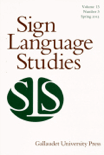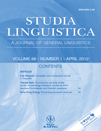
Natural Language Semantics
Scope & Guideline
Defining the Future of Linguistic Meaning
Introduction
Aims and Scopes
- Exploration of Meaning Structures:
The journal emphasizes the analysis of how meaning is constructed in language, including the roles of quantification, modality, and evidentiality. - Cross-Linguistic Semantics:
A core focus is on comparative studies across languages, highlighting how semantic principles apply differently or similarly in diverse linguistic contexts. - Integration of Syntax and Semantics:
The interplay between syntactic structures and semantic interpretation is a key area of study, exploring how grammatical constructions influence meaning. - Psycholinguistic Approaches to Semantics:
Research incorporating psycholinguistic methods to investigate how semantic understanding is processed and represented in the mind. - Presupposition and Implicature:
The journal frequently addresses presuppositional and implicational phenomena, examining how these elements function within discourse and contribute to overall meaning.
Trending and Emerging
- Event Modality and Tense:
There is an increasing focus on how event modality interacts with tense in various languages, which is crucial for understanding temporal semantics and narrative structure. - Evidentiality and Discourse:
Research on evidentiality is gaining prominence, particularly how it affects discourse and contributes to the interpretation of statements in languages with rich evidential marking. - Complex Predication and Possession:
Emerging studies are examining complex predicates and possessive constructions in various languages, shedding light on how these structures convey meaning about mental states and relationships. - Quantification and Contextual Factors:
The exploration of quantification, especially in relation to contextual influences and pragmatic aspects, is becoming a significant focus, indicating a shift towards more integrated semantic theories. - Psycholinguistic Evidence in Semantics:
There is a growing trend of incorporating psycholinguistic evidence to support theoretical claims in semantics, emphasizing the cognitive processes underlying language comprehension and meaning.
Declining or Waning
- Traditional Formal Semantics:
There has been a noticeable decrease in papers strictly adhering to traditional formal semantics approaches, with a shift towards more integrative methodologies that include cognitive and contextual factors. - Focus on Specific Language Studies:
The journal is moving away from narrowly focused studies on individual languages, as researchers increasingly seek broader, cross-linguistic perspectives and comparative analyses. - Static Meaning Analysis:
Research centered on static interpretations of meaning is less prevalent, with a growing interest in dynamic and context-sensitive approaches that consider how meaning evolves in discourse.
Similar Journals

Cognitive Semantics
Exploring the Intersection of Cognition and SemanticsCognitive Semantics, published by BRILL, is a leading academic journal dedicated to the intricate study of cognitive processes underlying language use and semantic meaning. With its ISSN 2352-6408 and E-ISSN 2352-6416, this journal contributes significantly to the fields of linguistics and language studies, reflecting its importance in contemporary research on cognitive linguistics. Over its publication span from 2015 to 2024, it has established a niche as a Q3 ranked journal in the Linguistics and Language category for 2023, showcasing its relevance and growing influence in the academic community. Although currently not open access, the journal aims to provide a robust platform for exchanging ideas, theories, and methodologies related to cognitive semantics, fostering interdisciplinary dialogue among researchers, professionals, and students. Readers can expect to uncover valuable insights into the cognitive mechanisms that shape our understanding of language, making this journal an essential resource for anyone involved in linguistic research.

SKASE Journal of Theoretical Linguistics
Bridging Heritage and Modernity in Linguistic ScholarshipSKASE Journal of Theoretical Linguistics, published by the SLOVAK ASSOCIATION STUDY ENGLISH-SKASE, is a distinguished Open Access journal that expands the horizons of linguistic research and theoretical frameworks. With its ISSN N/A and E-ISSN 1336-782X, the journal has established itself as a pivotal resource for scholars in the field, achieving a commendable Q2 ranking in Linguistics and Language as of 2023. The journal, which has been in continuous publication since 2017, actively publishes innovative research studies, reviews, and theoretical discussions, easing access to groundbreaking work for academics and practitioners alike. Based in Slovakia, it connects a rich heritage of linguistic scholarship and is indexed in Scopus, ranking alongside its peers in both Arts and Humanities and Social Sciences categories. The SKASE Journal of Theoretical Linguistics is crucial for anyone interested in the evolving landscapes of linguistics, serving as an invaluable platform for disseminating knowledge and fostering collaboration amongst researchers worldwide.

Sign Language Studies
Pioneering research in the realm of sign linguistics.Sign Language Studies is a prestigious peer-reviewed journal dedicated to advancing the field of sign language research and the linguistic studies surrounding it. Published by Gallaudet University Press, this journal stands out in the realms of Linguistics and Language, being classified within the Q2 category as of 2023, which underscores its influence and relevance within academic circles. Operating under the ISSN 0302-1475 and E-ISSN 1533-6263, the journal has a remarkable Scopus ranking that positions it in the top 20% within the disciplines of Arts and Humanities and Social Sciences, attesting to the high quality and impact of its publications. Spanning a comprehensive timeline from 2002 to 2024, Sign Language Studies invites researchers, professionals, and students to engage with cutting-edge research, theoretical frameworks, and practical studies that contribute to our understanding of sign languages, their structure, use, and the communities they serve. This makes it an essential resource for those committed to the exploration and appreciation of sign language within both linguistic and social contexts.

Studia Semiotyczne
Pioneering Research at the Intersection of DisciplinesStudia Semiotyczne is a prominent academic journal dedicated to the interdisciplinary study of semiotics, linguistics, and philosophy, published by the esteemed Polskie Towarzystwo Semiotyczne. With its ISSN 0137-6608 and E-ISSN 2544-073X, this journal has established itself as an essential platform for scholars in these fields. Since transitioning to Open Access in 2010, Studia Semiotyczne provides unrestricted access to groundbreaking research, thereby fostering scholarly exchange and collaboration globally. The journal has been recognized in the Q2 category in both Linguistics and Language and Philosophy in 2023, reflecting its quality and impact in these disciplines. By covering a range of topics within semiotics and related studies, it aims to advance understanding and stimulate dialogue among researchers and practitioners alike, making it an indispensable resource for those seeking to explore the complexities of meaning and communication in contemporary society.

Yuyan Kexue-Linguistic Sciences
Fostering Scholarly Exchange in Language StudiesYuyan Kexue-Linguistic Sciences, published by SCIENCE PRESS, is a pivotal academic journal dedicated to the field of linguistics. With its ISSN of 1671-9484, this journal seeks to explore and illuminate various linguistic phenomena, contributing significantly to the understanding of language in both theoretical and applied contexts. Emphasizing interdisciplinary research, it welcomes contributions that bridge linguistics with areas such as cognitive science, sociology, and communication studies. Although it currently does not offer open access, Yuyan Kexue-Linguistic Sciences aims to provide a platform for researchers, professionals, and students alike to engage with cutting-edge studies and emerging trends in linguistics. Its publication location in Beijing positions it as a vital contributor to the global discourse in the linguistic sciences, catering to both a national and international audience. As the journal continues to grow, it aspires to maintain high academic standards and foster scholarly exchange for years to come.

LINGUISTICS AND PHILOSOPHY
Unpacking the Philosophical Dimensions of Linguistic TheoryLINGUISTICS AND PHILOSOPHY, published by Springer, is an esteemed peer-reviewed journal that serves as a vital interdisciplinary platform for scholars engaged in the intricate interplay between linguistic and philosophical inquiry. With a strong impact factor, this journal falls under the prestigious Q1 category in both Linguistics and Language and Philosophy, illustrating its significant contribution to these fields. The journal's scope encompasses a wide array of topics, including semantics, pragmatics, language theory, and the philosophical implications of linguistic theory, making it essential reading for researchers and professionals alike. Operating in the vibrant academic context of the Netherlands, LINGUISTICS AND PHILOSOPHY has maintained a vital connection to current trends in language studies and philosophical thought since its inception in 1977. With consistently high rankings in Scopus, the journal reflects its commitment to disseminating high-quality research that influences ongoing discussions in both disciplines. Even without Open Access options, its relevance and robust editorial standards continue to attract a global readership dedicated to advancing knowledge at the intersection of linguistics and philosophy.

Snippets
Illuminating contemporary issues through rigorous scholarship.Snippets is an esteemed academic journal published by LED EDIZIONI UNIV, known for its commitment to advancing knowledge across various disciplines. The journal, which carries the ISSN 1590-1807, serves as a crucial platform for researchers, professionals, and students in the fields of humanities, social sciences, and applied sciences. With an increasing emphasis on open-access content, Snippets offers a wealth of information and insights aimed at fostering academic dialogue and innovation. Although specific metrics like impact factor and H-index are yet to be established, the journal is dedicated to providing high-quality research outputs that contribute to the enrichment of scholarly pursuits. Based in Milan, Italy, Snippets welcomes contributions from a diverse range of perspectives, thus enhancing interdisciplinary collaboration and promoting a deeper understanding of contemporary issues.

STUDIA LINGUISTICA
Unveiling the Rich Tapestry of Language StudiesSTUDIA LINGUISTICA is a prestigious journal published by Wiley, focusing on the dynamic and multifaceted fields of Linguistics and Language. With an ISSN of 0039-3193 and an E-ISSN of 1467-9582, the journal has been a vital resource for academics since its inception in 1947, diligently converging insights from history and philosophy of science alongside contemporary linguistic research. Demonstrating excellent scholarly impact, STUDIA LINGUISTICA proudly holds a Q1 ranking in Linguistics and Language as well as a Q2 in History and Philosophy of Science as of 2023, indicating its significance within these academic domains. Furthermore, it ranks in the top percentiles among similar journals, with a commendable 73rd percentile in Language and Linguistics and 70th in related social sciences. Although it does not offer Open Access, its contribution to the discourse of language studies is underpinned by rigorous peer-review processes and commitment to advancing theoretical and empirical research. For researchers, professionals, and students alike, STUDIA LINGUISTICA remains an essential platform for disseminating impactful linguistic scholarship worldwide.

Glossa-A Journal of General Linguistics
Catalyzing Critical Discourse in Language StudiesGlossa: A Journal of General Linguistics, published by the Open Library of Humanities, stands as a leading voice in the realm of linguistic research since its inception in 2016. With its Q1 category ranking in Linguistics and Language and impressive Scopus ranks encompassing the top 83rd and 81st percentiles in its respective fields, Glossa fosters a vibrant academic community committed to the rigorous exploration of language and linguistic theory. Operating under an open access model, the journal not only enhances the visibility of groundbreaking research but also ensures that valuable insights are accessible to a global audience. The journal's commitment to interdisciplinary dialogue makes it an indispensable resource for scholars, professionals, and students eager to engage with contemporary developments in linguistics. As it converges into 2024, Glossa continues to champion innovative scholarship and critical discourse that challenges conventional boundaries within the field.

Journal of Slavic Linguistics
Fostering Insights into Slavic Phonetics and SyntaxJournal of Slavic Linguistics, published by SLAVICA PUBLISHERS, is a key academic resource dedicated to the exploration of Slavic languages and linguistics. Established to provide a comprehensive platform for scholarly research, this journal addresses the intricate dynamics of Slavic phonetics, syntax, semantics, and discourse, making significant contributions to both theoretical and applied linguistics. The journal holds an impact factor that reflects its value in the linguistic community, particularly as it is ranked in the Q4 category in Linguistics and Language for 2023. With a focus on a wide range of topics within the field, the Journal of Slavic Linguistics serves as an essential reference for researchers, educators, and students alike, fostering an appreciation and deeper understanding of Slavic linguistic phenomena. Although currently not an Open Access journal, it remains accessible to a broad audience keen on engaging with contemporary linguistic scholarship.